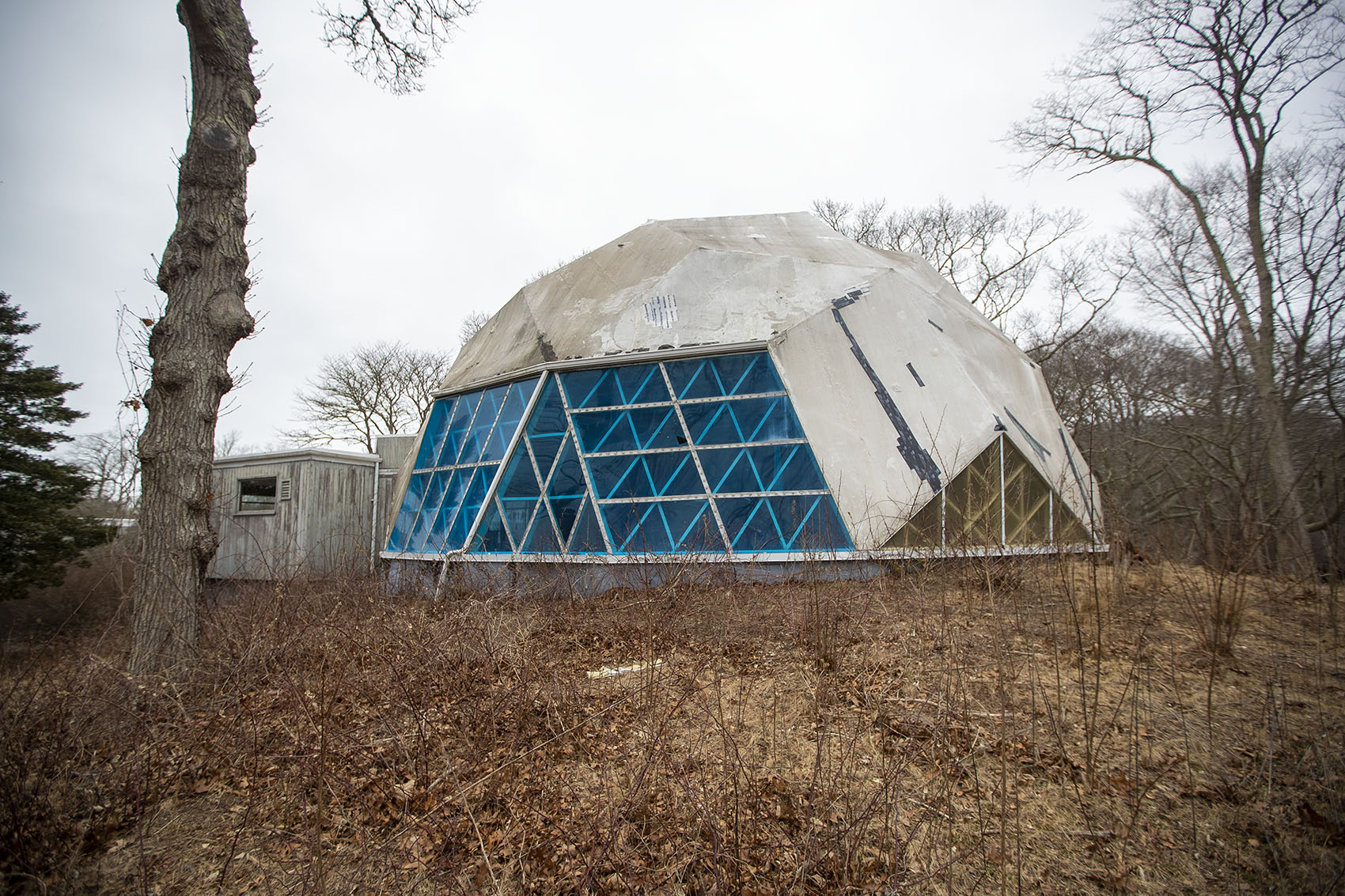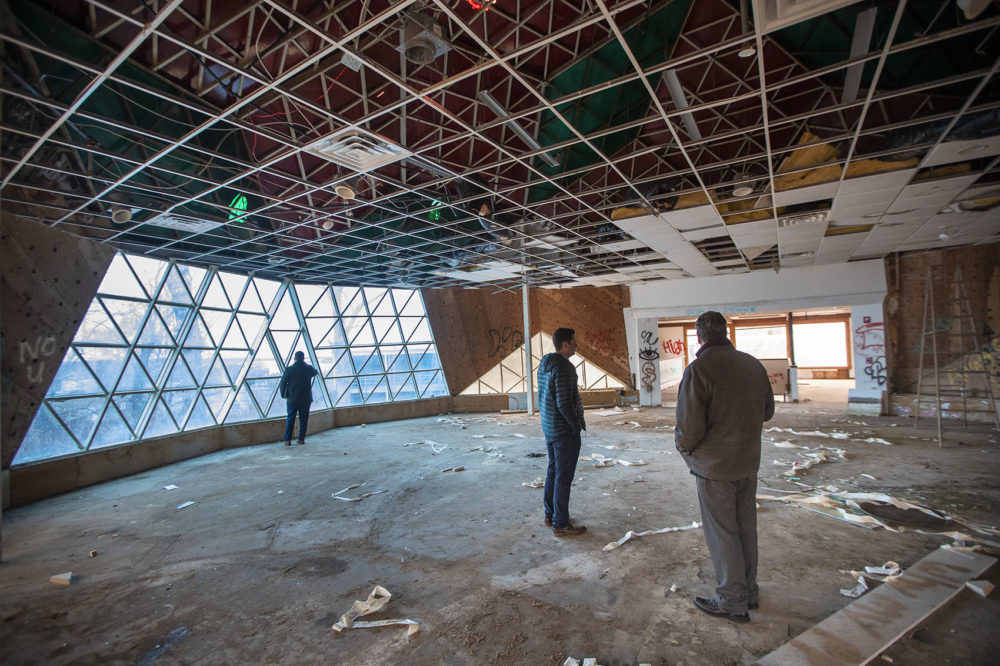Episode 137: Decaying Buildings Force Towns To Consider History; The Complicated Path Of Power From Quebec

This week on NEXT:
A side-by-side comparison of Northern Pass and New England Clean Energy Connect, and what’s next for the transmission line that will bring hydropower from Canada to Massachusetts.
Plus, we hear from a Vermont woman about her opioid addiction, and how she is moving towards recovery.
And we visit two old buildings that are making communities re-think what role history should play in their future.
It’s NEXT.
Photo at the top of the page: The interior of Buckminster Fuller’s geodesic dome in Woods Hole. Photo by Jesse Costa for WBUR
Comparing Northern Pass and New England Clean Energy Connect

The proposed Northern Pass route would bury the line in the White Mountains as a concession to opponents. Photo courtesy of Northern Pass
This week we’re going to take you on a journey. It starts in frigid Québec, where a gigantic, decades-old project that dammed rivers and forced native people off their land and has become a source of provincial pride, and a lot of power.
Power-hungry Massachusetts saw Hydro-Québec’s big dams as a zero-carbon answer to their prayers. The state solicited bids for all kinds of projects to bring 1,200 megawatts of renewable energy to the Commonwealth. And in January of 2018, the state announced it had picked the Northern Pass transmission line–a project of giant utility Eversource–to deliver a big chunk of that power in through New Hampshire. Northern Pass was controversial from the start, and only a week after the announcement, New Hampshire’s site evaluation committee denied the final permit for the project.
Massachusetts then went to Plan B which is creating a different transmission line from Québec that cuts through the state of Maine: Central Maine Power’s New England Energy Connect. Now, a year later, this project while also controversial, is getting more and more support, including from Maine Governor Janet Mills.
So what about these two projects led to such different outcomes? And what does it mean for the energy mix for our entire region?
We called up two reporters who have been covering these issues closely: New Hampshire Public Radio’s Annie Ropeik and Maine Public’s Fred Bever.
For more on Hydro-Québec go listen to Outside/In‘s Powerline Series.
A Story of Addiction and Recovery
Abbie Holden recently recorded an interview with Writers for Recovery and Vermont Public Radio, where she discussed her addiction and her path to recovery as part of their new podcast series, My Heart Still Beats. In the interview, she speaks with Gary Miller, creative director of Writers for Recovery, and the co-host of My Heart Still Beats.
We invited Gary Miller into the studio to discuss the series with us and the work Writers for Recovery is doing.
My Heart Still Beats was produced by Gary, along with Bess O’Brien, and editor Erica Heilman. Music is by Brian Clark. VPR’s managing editor for podcasts is Angela Evancie. The series was made possible by the VPR Innovation Fund. Listen to My Heart Still Beats.
Reconciling a Town’s Grand History with a Troubled Recent Past

Small businesses including an upscale coffee shop have recently opened on Main Street, intermingling with crumbling buildings. Photo by Cassandra Basler for WSHU
You can find two grand old hotels on Main Street in Willimantic, a small mill town in Eastern Connecticut. They hosted movers and shakers from New York and Boston during the golden age of train travel. The hotels fell into disrepair when travelers took to the highways. Cheap rooms, cheap heroin, and social services drew addicts, sex workers and the unemployed.
WSHU’s Cassandra Basler reports on how a plan to demolish the buildings may force the town to reconcile its grand history and troubled recent past.
Debating The Future of Woods Hole’s Geodesic Dome

The Dome in Woods Hole, the oldest surviving geodesic dome in the world built by Buckminster Fuller, is in a state of total disrepair. Photo by Jesse Costa for WBUR
In 1953, New England native Buckminster Fuller brought a radical idea to life. The futurist and famed architect built one of the first spherical buildings in the U.S. – a geodesic dome. Now the oldest surviving wood-framed dome in the seaside village of Woods Hole has the community up in arms about how to preserve it.
WBUR’s Cristela Guerra has our story.
About NEXT
NEXT is produced at Connecticut Public Radio
Host: John Dankosky
Producer: Lily Tyson
Digital Producer: Carlos Mejia
Senior Director: Catie Talarski
Contributors to this episode: Fred Bever, Annie Ropeik, Angela Evancie, Cassandra Basler, Cristela Guerra
Music: Todd Merrell, “New England” by Goodnight Blue Moon, “The River” by Ibeyi, “Sagittarius by Moonlight” by The Olympians
—
New to NEXT? You can find every episode or one you missed within our archives.
We need your feedback! Send critiques, suggestions, questions, and ideas to next@ctpublic.org. Help us spread the word! If you like what you hear, rate and review us on iTunes.




